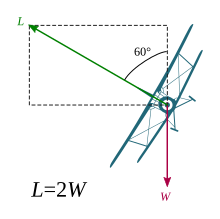
Back قوة التسارع Arabic G qüvvəsi AZ Перагрузка (авіяцыя) BE Força g Catalan G-kraft Danish G-Kraft German Fuerza g Spanish Ülekoormus (füüsika) ET نیروی گرانش FA G-voima Finnish
This article needs additional citations for verification. (October 2022) |


The g-force or gravitational force equivalent is mass-specific force (force per unit mass), expressed in units of standard gravity (symbol g or g0, not to be confused with "g", the symbol for grams). It is used for sustained accelerations, that cause a perception of weight. For example, an object at rest on Earth's surface is subject to 1 g, equaling the conventional value of gravitational acceleration on Earth, about 9.8 m/s2.[1] More transient acceleration, accompanied with significant jerk, is called shock.
When the g-force is produced by the surface of one object being pushed by the surface of another object, the reaction force to this push produces an equal and opposite force for every unit of each object's mass. The types of forces involved are transmitted through objects by interior mechanical stresses. Gravitational acceleration is one cause of an object's acceleration in relation to free fall.[2][3]
The g-force experienced by an object is due to the vector sum of all gravitational and non-gravitational forces acting on an object's freedom to move. In practice, as noted, these are surface-contact forces between objects. Such forces cause stresses and strains on objects, since they must be transmitted from an object surface. Because of these strains, large g-forces may be destructive.
For example, a force of 1 g on an object sitting on the Earth's surface is caused by the mechanical force exerted in the upward direction by the ground, keeping the object from going into free fall. The upward contact force from the ground ensures that an object at rest on the Earth's surface is accelerating relative to the free-fall condition. (Free fall is the path that the object would follow when falling freely toward the Earth's center). Stress inside the object is ensured from the fact that the ground contact forces are transmitted only from the point of contact with the ground.
Objects allowed to free-fall in an inertial trajectory under the influence of gravitation only feel no g-force, a condition known as weightlessness. It is also termed "zero-g", although the more correct excision is "zero g-force". This is demonstrated by the zero g-force conditions inside an elevator falling freely toward the Earth's center (in vacuum), or (to good approximation) conditions inside a spacecraft in Earth orbit. These are examples of coordinate acceleration (a change in velocity) without a sensation of weight.
In the absence of gravitational fields, or in directions at right angles to them, proper and coordinate accelerations are the same, and any coordinate acceleration must be produced by a corresponding g-force acceleration. An example here is a rocket in free space, in which simple changes in velocity are produced by the engines and produce g-forces on the rocket and passengers.
- ^ Deziel, Chris. "How to Convert Newtons to G-Force". sciencing.com. Retrieved 17 January 2021.
- ^ G Force Archived 25 January 2012 at the Wayback Machine. Newton.dep.anl.gov. Retrieved on 2011-10-14.
- ^ Sircar, Sabyasachi (12 December 2007). Principles of Medical Physiology. Thieme. ISBN 978-1-58890-572-7.